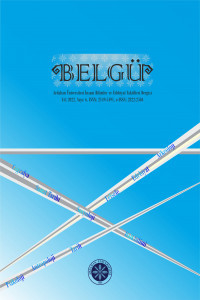Trakya Bölgesinde Köstek Kesme Ritüeli
Kültür, geçmişin birikimiyle gelecek nesillere aktarılan maddi ve manevi değerlerin toplamıdır. Bu
kültürler ritüelleri içerir. Bu çalışmada Trakya Bölgesi’nde bir geçiş ritüeli olan köstek kesme riti detaylı
olarak incelenmiştir. Köstek kesme ritüeli çocuğun ilk adım atmasının kutlanmasına dayalı bir rittir.
Bazen ise yürümeye başlayamamasının nedeni olarak görülür ve bu rit çocuğun yürümeye başlaması
amacı ile yapılmaktadır. Çocuğun ilk adımı kendi başına atması, onun büyüdüğüne bir işarettir ve
Türklerce kutlamaya değer bir geçiş olarak kabul edilmektedir. Kökeni eski Türk inanışlarına kadar
dayanan bu ritüel eskiden Trakya Bölgesi’nde yoğun olarak kutlanmaktadır. Günümüzde ise bu ritin
kutlanma sıklığı giderek azalmaktadır. Araştırmanın hipotezi de bu savın araştırılmasına dayalı olarak:
‘İleride Trakya Bölgesi’nde köstek kesme ritüeli yapılmayacak’ varsayımına dayanmaktadır.
Çalışmanın amacı hem nitel hem de nicel yöntemler ile analiz edilmiştir. Nitel yöntemlerden kültür
analizi tekniği ve nicel yöntemlerden anket çalışması uygulanmıştır. Her iki yöntemin
kullanılmasındaki amaç bu ayin için sosyal ve kültürel değerlerde meydana gelen değişimleri
derinlemesine incelemektir. Ayrıca Trakya Bölgesi’nde düzenlenen bu ritüele bizzat katılım sağlanmış
ve bu ritüel hakkında ilgili kişilerle yüz yüze görüşülmüştür. Geçmiş yıllarda kırsal kesimde yoğun bir
şekilde gerçekleştirilen bu ritüelin kent toplumunda yeterince ilgi görmediği ve gelecekte bu ritüelin
yapılmayacağı bulgusu gözlem, yapılandırılmış kişisel görüşme ve yüz yüze görüşme yoluyla elde
edilmiştir.
Anahtar Kelimeler:
Köstek, Rituel, Trakya Bölgesi, Çocuk
SHACKLE RITUAL IN THRACE REGION
Culture is the sum of material and spiritual values transferred to future generations with the
accumulation of the past. These cultures include rituals. In this study, the Köstek Kesme, which is a rite of
passage in the Thrace Region, was examined in detail. The Köstek Kesme ritual is a ritual based on the
celebration of the child’s first step. Sometimes it is seen as the reason for not being able to start walking,
and this rite is carried out with the aim of helping the child start to walk. The fact that a child takes the
first step on his own is a sign that he has grown up and is considered a transition worth celebrating by
the Turks. This ritual, which dates to ancient Turkish beliefs was intensely celebrated in the Thrace
Region in the past. Today, the frequency of the celebration of this rite is gradually on the decrease. The
hypothesis of the research is based on an assumtion that the ritual will not be performed in the Thrace
Region in the future. The aim of the study was analyzed with both qualitative and quantitive methods.
Cultural analysis technique, a form of qualitative methods and survey study, a form of quantitative
method were used. The purpose of using both methods is to examine in depth the changes in social and
cultural values experienced in this ritual. In additon, this ritual held in the Thrace Region was
personally attended and a face-to-face interview was held with the relevant people involved in this
ritual. The results obtained from personal observations, personal structured interview and a face-to-face
interview indicated that the ritual intensly performed in rural areas in previous years did not attract
enough attention in urban areas, and thus such rituels would no longer be performed in the future.
Keywords:
shackle ritual, Thrace Region, Köstek Kesme, child,
___
- Aktan, C. C., & Tutar, H. (2007). Bir sosyal sabit sermaye olarak kültür. Pazarlama ve İletişim Kültürü Dergisi, 6(20), 1-11.
- Arık, D. (2005). Azerbaycan Türklerinin dini tarihi ve halk inanışları. Öztepe Matbaacılık.
- Belk, R. W. Kenneth D. Bahn, and Robert N. Mayer (1982),“Developmental Recognition of Consumption Symbolism,”. Journal of Consumer Research, 9(1), 4-17.
- Çetin, H. (2018). Kazaklar Türklerinde çocuk ile ilgili gerçekleştirilen törenler ve çocuk terbiyesi. Avrasya Uluslararası Araştırmalar Dergisi, 6(15), 1088-1101.
- De Coppet, D. (Ed.). (1992). Understanding rituals (p. 1). London: Routledge.
- Erdoğan M (2009). Türkiye için Metropol ve Kır-Kent Tanımı Önerisi. Yayınlanmamış TUİK Uzmanlık Tezi, Ankara.
- ISSN: 2149-5491
- Yayın Aralığı: Yılda 2 Sayı
- Başlangıç: 2015
- Yayıncı: Ardahan Üniversitesi
Sayıdaki Diğer Makaleler
BİLİMSEL MAKALE HAZIRLAMA SÜRECİNDE TEMEL İLKELER
ALA SÖZCÜĞÜNÜN KIRGIZCADAKİ KULLANIM ALANI VE ANLAM EVRENİYLE İLGİLİ DÜŞÜNCELER
KARŞILAŞTIRMALI EDEBİYAT AÇISINDAN MİT, MİTOKRİTİK VE SEMBOLİK İMGELEM
KİTÂB-I MUKADDES’TE YARATILIŞ MİTOLOJİSİNİN KUR’ÂN VE SÜNNETE GÖRE DEĞERİ
AYSEL GÜRMEN'İN ESERLERİNDE İLETİLEN DEĞERLER BAĞLAMINDA BİR İNCELEME
METİNLERARASI İLİŞKİLER BAĞLAMINDA MURATHAN MUNGAN’IN KIRK ODA DİZİSİ HİKÂYELERİNDE “OİDİPUS MİTOSU”
